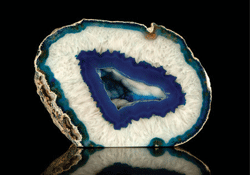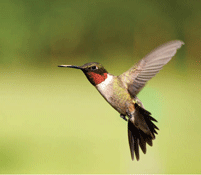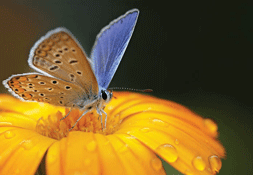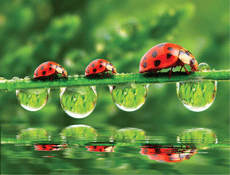

 Life is full of beauty. In the early days of the Does God Exist? ministry when we traveled long distances to lectureships in a station wagon pulling a pop-up trailer, my wife's mother went with us. Edith was a collector of anything she saw beauty in, which meant her house was full of things she collected. She shared my interest in geology and rocks, and she loved to collect geodes. The outside of a geode is not impressive but if you cut it in half with a rock saw or smash it with a hammer you will find the inside is full of beautiful colors — purple (amethyst), red (jasper), yellowish brown (iron), orange (agate), or light blue (chalcedony). She would also buy slices of rocks that had veins of minerals running through them that were full of color and intricate designs.
Life is full of beauty. In the early days of the Does God Exist? ministry when we traveled long distances to lectureships in a station wagon pulling a pop-up trailer, my wife's mother went with us. Edith was a collector of anything she saw beauty in, which meant her house was full of things she collected. She shared my interest in geology and rocks, and she loved to collect geodes. The outside of a geode is not impressive but if you cut it in half with a rock saw or smash it with a hammer you will find the inside is full of beautiful colors — purple (amethyst), red (jasper), yellowish brown (iron), orange (agate), or light blue (chalcedony). She would also buy slices of rocks that had veins of minerals running through them that were full of color and intricate designs.
 We love the beauty of the birds on our feeders, especially the ruby-throated hummingbirds. We marvel at the colors of the butterflies that visit our special butterfly bushes, and we relish the smell of our roses. The flicker of fireflies, the song of a wren, and the intricate pattern of diatoms under an electron microscope all impress us with the beauty built into the creation around us.
We love the beauty of the birds on our feeders, especially the ruby-throated hummingbirds. We marvel at the colors of the butterflies that visit our special butterfly bushes, and we relish the smell of our roses. The flicker of fireflies, the song of a wren, and the intricate pattern of diatoms under an electron microscope all impress us with the beauty built into the creation around us.
But what is beauty, and why should it exist? Is it an intrinsic property of our world — ike mass? Is it an artifact of human perception? Does it arise by the operation of physical laws, and if so, how do these laws generate a quality so pleasing to us that we strive to create it? Is it something done by a Designer who values beauty and wants to impart that value to those created in his image?
 From the position of a utilitarian naturalist, natural selection is the sole cause of beauty. The smelliest flowers are the ones that get pollinated the most by insects, so roses are simply selected over less fragrant plants. The colors of birds and butterflies and frogs are just camouflage according to this view and we just like the camouflage. There are many problems with this explanation. The extravagance of design is far beyond what is needed for basic camouflage. Many of the animals involved are color blind, so the elaborate color patterns are unnecessary. Look at the bleeding heart or the iris and ask why the flair? Many examples of beauty are in nonliving things and thus not selected in my way. Sunsets, sunrises, the auroras, mineral colors, the intricate patterns in snowflakes, patterns in galaxies and nebula are generally unnecessary to their existence. If the universe is only a machine grinding away for billions of years then its beauty has no value. Those things we think are beautiful are just a commodity to be used up — to suit our appetites. Nothing is of value unless it is useful to human beings — now or in some future generation. What good is a wilderness to a naturalist? If you cannot drill for oil — why protect the wild? What good are salmon if we can grow them in concrete vats? What good is a forest if it does not yield board feet of lumber? Why worry about non-human species if they are not fit and you are? Measured by its consequences, the utilitarian ethic and the naturalistic foundation on which it has been built have been disastrous.
From the position of a utilitarian naturalist, natural selection is the sole cause of beauty. The smelliest flowers are the ones that get pollinated the most by insects, so roses are simply selected over less fragrant plants. The colors of birds and butterflies and frogs are just camouflage according to this view and we just like the camouflage. There are many problems with this explanation. The extravagance of design is far beyond what is needed for basic camouflage. Many of the animals involved are color blind, so the elaborate color patterns are unnecessary. Look at the bleeding heart or the iris and ask why the flair? Many examples of beauty are in nonliving things and thus not selected in my way. Sunsets, sunrises, the auroras, mineral colors, the intricate patterns in snowflakes, patterns in galaxies and nebula are generally unnecessary to their existence. If the universe is only a machine grinding away for billions of years then its beauty has no value. Those things we think are beautiful are just a commodity to be used up — to suit our appetites. Nothing is of value unless it is useful to human beings — now or in some future generation. What good is a wilderness to a naturalist? If you cannot drill for oil — why protect the wild? What good are salmon if we can grow them in concrete vats? What good is a forest if it does not yield board feet of lumber? Why worry about non-human species if they are not fit and you are? Measured by its consequences, the utilitarian ethic and the naturalistic foundation on which it has been built have been disastrous.
 Those of us who believe in God concur with biologist J. B. S. Haldane's discussion of the enormous range of colors and patterns in beetles when he said, “the cosmic designer must be inordinately fond of beauty.” Offering no survival benefit the logarithmic spiral of the nautilus caused Descartes to identify the mathematical beauty of what his equations described. The beauty around us provides standards for science, language, and literature. It calls us out of ourselves and inspires affection and gratitude. Rejoice in it. Care for it.
Those of us who believe in God concur with biologist J. B. S. Haldane's discussion of the enormous range of colors and patterns in beetles when he said, “the cosmic designer must be inordinately fond of beauty.” Offering no survival benefit the logarithmic spiral of the nautilus caused Descartes to identify the mathematical beauty of what his equations described. The beauty around us provides standards for science, language, and literature. It calls us out of ourselves and inspires affection and gratitude. Rejoice in it. Care for it.
Picture credits:
© Permian. Image from BigStockPhoto.com.
© Sari ONeal. Image from BigStockPhoto.com
© Serg64. Image from BigStockPhoto.com
© Kletr. Image from BigStockPhoto.com
